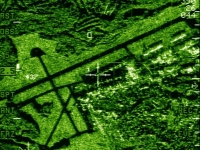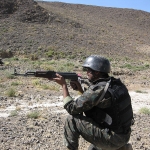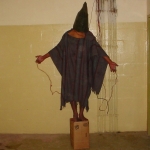Drone, Inc. - F. Ground Moving Target Indicator

The Pentagon has been using basic tracking algorithms for a very long time, notably in radar systems that bounce radio waves off distant objects to “look” beyond the range of the human eye.
In World War II, for example, Ford Instrument Company used algorithms in its primitive computers to aim missiles at enemy ships.94 Such technologies allowed the Navy to hit targets it could not see. Radar algorithms are also routinely used to monitor intruders at airfield perimeters or enclosed compounds.
Targeting ships at sea and watching walls and gates are easy tasks, since large objects can easily be monitored against a relatively uniform canvas. But radar has a much harder time dealing with what engineers call “noise and clutter.” When watching the ground from an overhead drone, tracking algorithms could be easily confused by sheep in a rural environment and by most moving objects in a complex urban area.95
In the Yugoslav war in the 1990s, for example, automatic target recognition (ATR) algorithms used to identify enemy tanks did not fare too well. “From our experience at three field exercises and a current operational deployment to the Bosnian theater, this is not the best way to get total system performance,” a 1997 military study concluded. “The human operator makes decisions based on learning, history of past events, and surrounding contextual information. Loss of these factors by providing imagery, latent with symbolic cues on top of the original imagery, actually increases the workload of the operator.96
The problems persist. “The ability of humans to discern targets is still significantly greater than that of electronic processing algorithms,” James Ratches, the former chief scientist of the Army’s Communications-Electronics Command Night Vision and Electro-Optics Directorate, wrote in a 2011 technical paper. “Full automatic target recognition may be unattainable, or at best, take a long time to mature.”97
| Ground Moving Target Indicator Vendors GMTI software often comes bundled with synthetic aperture radar systems. One of the companies that provides GMTI software for Predator and Reaper drones is Australia-based Sentient Vision Systems, which sells a product called Kestrel. “We reliably detect targets down to two-by-two pixels in size, but with proven performance down to a half pixel in certain conditions,” Tom Loveard, Sentient’s chief technology officer claimed to Tactical ISR Technology. “Kestrel watches every pixel, hour after hour, and enables operators to concentrate on detected targets, rather than draining their focus with the base search task.”100 Northrup Grumman and RadiantBlue of Florida also develop and sell GMTI software for use on drones.101 |
Despite this, drone crews rely on algorithms like Kalman and Interacting Multiple Model in Ground Moving Target Indicator (GMTI) software to help point a drone camera by tracking the paths of objects and people on the ground. David Fulcher, deputy director of the U.S. Northern Border Facility and an experienced Reaper pilot himself, explained why to UAS magazine in 2016. “The cameras are pretty small with a narrow field of view, It can’t do wide-area collection at the same time,” Fulcher said. “You have to know what you’re looking for in order to be able to see it on the camera.”98
For Fulcher’s job—tracking people sneaking across the U.S. border—GMTI might seem like an ideal solution, given that he does not need to know the names, citizenship or the motives of the individual. Once the radar spots moving objects, a drone crew can zoom in with a camera. “You can pick out things like a group of smugglers coming across the border. You can tell how many there are. You can tell that they’re carrying backpacks,” Fulcher adds. Then all he has to do is send out a Border Patrol team to arrest them and the legal system does the rest.
Yet a December 2014 assessment of the performance of a fleet of ten Predators used to police the U.S.-Mexico border for eight years, conducted by the inspector general of the Department of Homeland Security, declared that the program was a dismal failure.99
In Arizona, Customs & Border Patrol (CBP) estimated that the Predators contributed 1.8 percent of all arrests, and in Texas, they helped in just 0.07 percent. “Although CBP anticipated increased apprehensions of illegal border crossers, a reduction in border surveillance costs, and improvement in the U.S. Border Patrol’s efficiency, we found little or no evidence that CBP met those program expectations,” the inspector general wrote.
< Previous • Report Index • Download Report • FAQ/Press Materials • Watch Video • Next >



